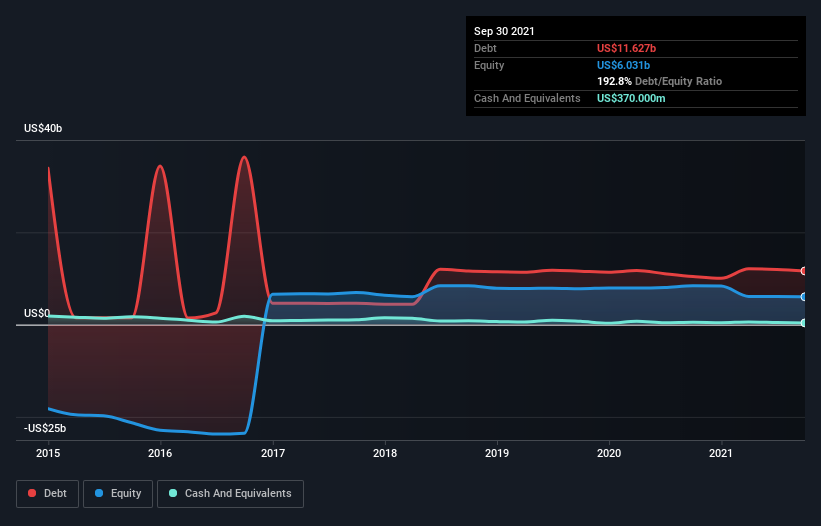- United States
- /
- Renewable Energy
- /
- NYSE:VST
Vistra (NYSE:VST) Has Debt But No Earnings; Should You Worry?
Howard Marks put it nicely when he said that, rather than worrying about share price volatility, 'The possibility of permanent loss is the risk I worry about... and every practical investor I know worries about.' So it might be obvious that you need to consider debt, when you think about how risky any given stock is, because too much debt can sink a company. As with many other companies Vistra Corp. (NYSE:VST) makes use of debt. But the more important question is: how much risk is that debt creating?
Why Does Debt Bring Risk?
Debt assists a business until the business has trouble paying it off, either with new capital or with free cash flow. In the worst case scenario, a company can go bankrupt if it cannot pay its creditors. However, a more frequent (but still costly) occurrence is where a company must issue shares at bargain-basement prices, permanently diluting shareholders, just to shore up its balance sheet. Of course, the upside of debt is that it often represents cheap capital, especially when it replaces dilution in a company with the ability to reinvest at high rates of return. When we think about a company's use of debt, we first look at cash and debt together.
See our latest analysis for Vistra
What Is Vistra's Debt?
The image below, which you can click on for greater detail, shows that at September 2021 Vistra had debt of US$11.6b, up from US$10.4b in one year. However, it does have US$370.0m in cash offsetting this, leading to net debt of about US$11.3b.

A Look At Vistra's Liabilities
We can see from the most recent balance sheet that Vistra had liabilities of US$7.92b falling due within a year, and liabilities of US$16.0b due beyond that. Offsetting this, it had US$370.0m in cash and US$1.54b in receivables that were due within 12 months. So it has liabilities totalling US$22.0b more than its cash and near-term receivables, combined.
This deficit casts a shadow over the US$9.95b company, like a colossus towering over mere mortals. So we'd watch its balance sheet closely, without a doubt. At the end of the day, Vistra would probably need a major re-capitalization if its creditors were to demand repayment. There's no doubt that we learn most about debt from the balance sheet. But ultimately the future profitability of the business will decide if Vistra can strengthen its balance sheet over time. So if you're focused on the future you can check out this free report showing analyst profit forecasts.
Over 12 months, Vistra made a loss at the EBIT level, and saw its revenue drop to US$11b, which is a fall of 4.2%. We would much prefer see growth.
Caveat Emptor
Importantly, Vistra had an earnings before interest and tax (EBIT) loss over the last year. Its EBIT loss was a whopping US$2.3b. When we look at that alongside the significant liabilities, we're not particularly confident about the company. It would need to improve its operations quickly for us to be interested in it. Not least because it burned through US$1.3b in negative free cash flow over the last year. That means it's on the risky side of things. There's no doubt that we learn most about debt from the balance sheet. But ultimately, every company can contain risks that exist outside of the balance sheet. For instance, we've identified 1 warning sign for Vistra that you should be aware of.
If you're interested in investing in businesses that can grow profits without the burden of debt, then check out this free list of growing businesses that have net cash on the balance sheet.
New: Manage All Your Stock Portfolios in One Place
We've created the ultimate portfolio companion for stock investors, and it's free.
• Connect an unlimited number of Portfolios and see your total in one currency
• Be alerted to new Warning Signs or Risks via email or mobile
• Track the Fair Value of your stocks
This article by Simply Wall St is general in nature. We provide commentary based on historical data and analyst forecasts only using an unbiased methodology and our articles are not intended to be financial advice. It does not constitute a recommendation to buy or sell any stock, and does not take account of your objectives, or your financial situation. We aim to bring you long-term focused analysis driven by fundamental data. Note that our analysis may not factor in the latest price-sensitive company announcements or qualitative material. Simply Wall St has no position in any stocks mentioned.
Have feedback on this article? Concerned about the content? Get in touch with us directly. Alternatively, email editorial-team (at) simplywallst.com.
About NYSE:VST
Vistra
Operates as an integrated retail electricity and power generation company in the United States.
Reasonable growth potential and slightly overvalued.
Similar Companies
Market Insights
Community Narratives




